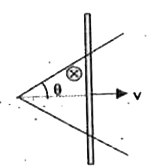A conducting bar of mass m length l is pushed with a speed V0 on a smooth horizontal conducting rail containing an inductance L. If the applied magnetic field has inward field induction B find the maximum distance covered by the bar before it stops. Assume that the induced current i=0 when the bar is at the position of the inductor .
(##FIITJEE_PHY_MB_05_C02_SLV_018_Q01.png" width="80%">
If the bar slides a distance dx the flux linkage dϕ=8l dx
⇒ The induced emf = - dϕdt=−Bldxdt
Since the induced emf across the inductor = Ldidt
⇒−Bldxdt=−Ldidt
⇒L∫0di=Bl∫x0dx
⇒Li=Blx⇒i=BlLx
This induced current interacts with the applied magnetic field of induction and imparting a restoring ( magnetic ) force F = −ilB.
⇒F=−(BlLx)lB
⇒mvdvdx=−B2l2Lx
⇒∫0v0vdv=−B2l2mL∫s0xdx,−v202=B2l2s22mL
⇒S=√my20LB2l2=(√mL).v0Bl

Topper's Solved these Questions
- ELECTROMAGNETIC INDUCTIONBOOK - FIITJEECHAPTER - ELECTROMAGNETIC INDUCTIONEXERCISE - SOLVED PROBLEMS ( OBJECTIVE)
15 Videos
- ELECTROMAGNETIC INDUCTIONBOOK - FIITJEECHAPTER - ELECTROMAGNETIC INDUCTIONEXERCISE - Comprehension Based Type Comprehension -I
3 Videos
- ELECTROMAGNETIC INDUCTIONBOOK - FIITJEECHAPTER - ELECTROMAGNETIC INDUCTIONEXERCISE - EXERCISE
9 Videos
- ELASTICITY AND WAVES BOOK - FIITJEECHAPTER - ELASTICITY AND WAVES EXERCISE - Assignment Problems (Objective) Level-II
15 Videos
- ELECTROMAGNETIC INDUCTION AND AC CURRENTBOOK - FIITJEECHAPTER - ELECTROMAGNETIC INDUCTION AND AC CURRENTEXERCISE - Example
15 Videos
Similar Questions
A conducting bar is pulled with a constant speed v on a smooth conducting rail. The region has a steady magnetic field of induction B as shown in the figure. If the speed of the bar is doubled then the rate of heat dissipation will

View SolutionTwo parallel long smooth conducting rails separated by a distance l are connected by a movable conducting connector of mass m. Terminals of the rails are connected by the resistor R and the capacitor C as shown in figure. A uniform magnetic field B perpendicular to the plane of the rail is switched on. The connector is dragged by a constant force F. Find the speed of the connector as a function of time if the force F is applied at t=0. Also find the terminal velocity of the connector.

View Solution
Knowledge Check
A conducting bar is pulled with a constant speed v on a smooth conducting rail. The region has a steady magnetic field of induction B as shown in the figure. If the speed of the bar is doubled then the rate of heat dissipation will
 Aremain constantBbecome quarter of the initial valueCbecome four foldDget doubled
Aremain constantBbecome quarter of the initial valueCbecome four foldDget doubledA conducting bar mass m and length l moves on two frictionless parallel conducting rails in the presence of a uniform magnetic field B0 directed into the paper. The bar is given an initial velocity v0 to the right and is released at t=0. The velocity of the bar as a function of time is given by
 Av0×mRtB20l2Bv0e−B20l2tmRCv0×e−2B20l2tmRDv0e−B20l2t2mR
Av0×mRtB20l2Bv0e−B20l2tmRCv0×e−2B20l2tmRDv0e−B20l2t2mRA conducting bar of mass m and length l moves on two frictionless parallel rails in the presence of a constant uniform magnetic field of magnitude B directed into the page as shown in the figure . The bar is given an initial velocity v0 towards the right at t = 0. Then the
 AInduced current in the circuit is in the clockwise directionBVelocity of the bar decreases linearly with timeCDistance the bar travels before it comes to a complete stop is proportional to RDPower generated across the resistance is proportional to l.
AInduced current in the circuit is in the clockwise directionBVelocity of the bar decreases linearly with timeCDistance the bar travels before it comes to a complete stop is proportional to RDPower generated across the resistance is proportional to l.
A conducting bar of sufficient length is pulled with a constant velocity in a conducting shaped rail as shown in the figure . Inward magnetic field of induction B is present inside the area bounded by the bar & the rail. Find the external power delivered in moving the rail with constant velocity v at time t ( A= area of cross section of the bar ρ= resistivity of the bar )

View SolutionA conductor (rod) of mass m, length l carrying a current i is subjected to a magnetic field of induction B. If the coefficients of friction between the conducting rod and rail is μ, find the value of I if the rod starts sliding.

View SolutionA conductor (rod) of mass m, length l carrying a current i is subjected to a magnetic field of induction B. If the coefficients of friction between the conducting rod and rail is μ, find the value of I if the rod starts sliding.

View SolutionA bar of mass m slides on a smooth horizontal conducting rail. A constant current I is maintained in the rod using a constant current generator as shown. There is a long straight conductor carrying current I0 parallel to the rod. Find the speed of the bar after it has travelled a distance D

View SolutionA conducting rod of length L=0.1m is moving with a uniform sped v=0.2m/s on conducting raisli a magnetic field B=0.5T as shown. On one side, the end of the rails is connected to a capacitor of capacitance C=20μF. Then, the charge on the capacitor's plates are

View Solution
